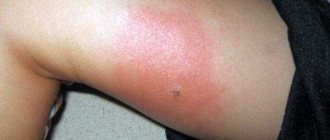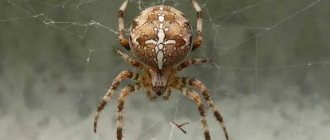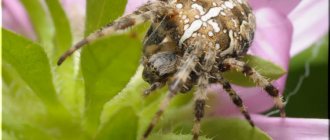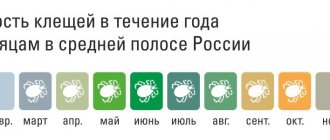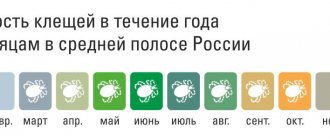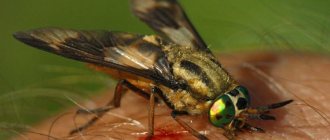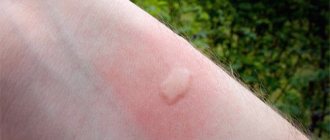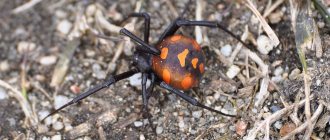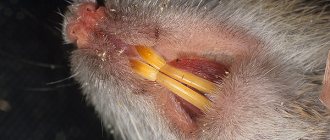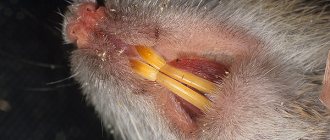These stories did not take place in the Amazon jungle or tropical Africa, or even in Central Asia. A yellow spider, inconspicuous at first glance, bit a man in the Krasnodar region. Right at home! His second relative in the Voronezh region stung a seven-year-old child. In another case, a woman living in Tolyatti was injured. Is this an accident or has the threat of being bitten really increased? We'll tell you how to recognize a dangerous spider and what to do if you couldn't avoid an encounter.
Yellow spider Sak (yellow sac spider)
The species was first described by the French naturalist Charles Joseph de Villers under the name Aranea punctoria in 1789.
The yellow sak spider usually hides, preferring tall grass, cultivated fields, and can also be seen under lying stones; this type of spider does not weave webs. During the day they are in shelters above the ground, in so-called “sleeping bags”, which have many holes. This type of poisonous spider is active at night, when it is time to hunt for its victims (snails, insects, and other spiders). The bite of this spider causes a necrotic ulcer, the symptoms of which disappear within 22-30 hours. Tissue death is accompanied by dizziness and fever. Sakis show aggression only for self-defense, protecting themselves or their offspring; frequent encounters occur in haymaking. Despite the danger, they are excellent helpers in agriculture, because... destroy pests.
What does a spider's web look like?
The spider does not spread its trapping nets in the form of a canvas, typical of many arachnids. Sak makes a bag out of dense web threads into which the victims are caught. A similar cocoon is weaved after fertilization to lay eggs. Often the web blocks the entrance to the shelter. The predator is engaged in weaving webs at night, and during the day it sits quietly in the chosen place.
Photo and description of appearance
The predatory sak spider is small in size. The body of the individual has a size of only 10-12 mm, with a span of about 25 mm with its limbs. Females are much larger than males. The body consists of the abdomen and cephalothorax. Covered with a dense shell. The forelimbs help to grab the prey and hold it while feeding, while having 4 pairs of legs.
The abdomen is bright yellow. The paws are predominantly slightly dark in color. The cephalothorax is red-brown in color and quite massive. When you see a saka spider, your attention is drawn to its powerful, pointed jaws, rounded at the edges. With this piercing weapon, the spider breaks the victim's shell (chitinous cover), and then injects its poison.
On a note!
The spider has 4 pairs of eyes on its head, which are crowded in the middle, but the spider has poor vision. The organs of touch and smell, located on the limbs, help to navigate the environment. The golden sak spider senses someone else's presence through vibrations in the air, smell, and web.
The male sak does not have a pronounced yellow-brown coat, like the females. The size including the limbs reaches an average of 16 mm. The main purpose of the male is to fertilize the female. After which the male dies.
A photo of the saka spider is presented below. You can examine the features of the body structure, color, and powerful jaws of the predator.
Yellow spider sak
Reproduction
The lifespan of a female is 1 year. The mating season begins in mid-summer, and towards the end the female lays eggs. For laying, it initially forms a cocoon-bag from its own web. At one time, the spider lays up to 600 eggs. The young take several weeks to develop. The female holds the cocoon near her, ensuring safe formation.
After birth, the cubs of the saka spider live with their mother for a long time. Initially, she provides them with food and teaches them to hunt. During the entire period of growing up, spiders go through up to 7 molts, each time increasing in size.
Interesting!
At the last stage, the genital organs are formed, the body acquires a characteristic color. Adult Cheiracanthiums eat the mother and begin to reproduce themselves.
Benefits and harm to the environment
Fact is, some species of spiders like the smell of gasoline and oil. This is explained by the desire of arthropods to weave a web near the internal combustion engine of the car, and accordingly can lead to vehicle malfunction.
Cheiracanthium is the owner of the most toxic poison on the European continent, although it is not fatal, but often causes real panic.
Symptoms of a saka bite:
- the bite after a while is accompanied by vomiting, nausea, headaches and fever;
- initially there are burning pains, which subside over time;
- the bite site turns red (blue) and then swells;
- After a certain amount of time, the bite site becomes covered with blisters.
Symptoms from the toxic poison, body aches, general weakness, disappear after 24-72 days from the moment of the bite. The bite mark can remain for up to 2 weeks. Attention! If after these periods of time there is a deterioration in your health, you should immediately consult a doctor.
Bronzewort is an insect with a shiny chitinous shell that causes a lot of trouble for flower growers.
Biological characteristics
In official biological language, argiope belongs to the family of orb-weaving spiders. This family is characterized by the production of a large circular catch net with a pronounced spiral stabilimentum in the center. This section of the web is clearly visible in ultraviolet rays, which are distinguishable by many insects, and therefore the stablimentum is so attractive to various insects and beetles.
Reference! Stabilimentum - threads of the web that form a zigzag pattern.
Appearance
Cheiracanthium is usually pale in color with a yellowish or beige belly, and is relatively small in size, 5–10 mm. It has eight eyes, arranged in two rows, of approximately the same width.
Males are distinguished by elongated chelicerae. The oral apparatus is an internal recess, and the chelicerae have lateral projections.
Eight legs with two claws. The forelimbs are longer and 1.5 times longer than the spider’s body. The lower legs have a small number of spine-like growths.
The web-forming apparatus is represented by anterior and posterior warts. The second often includes an elongated apical segment.
The respiratory system is represented by pairs of lungs and tracheas. The spiracle is located in front of the arachnoid warts. The abdomen is oval in shape and slightly pointed at the end.
Appearance
According to the description, the Argiope spider really looks like a wasp or a zebra. The body of the arthropod clearly shows an alternation of black and yellow stripes, however, this is characteristic only of females. Males of this species are small and inconspicuous.
Argiope Brünnich spiders exhibit pronounced dimorphism. The female has a body size of 15-30 millimeters in length, while the male Argiope barely reaches half a centimeter.
Spreading
This striped black and yellow spider mainly inhabits the middle and southern regions of Europe and Russia. But recently, thanks to climate warming, argiope has begun to be found in the northern regions. There is information that our spider was seen in the Moscow and Nizhny Novgorod regions, and even further north.
Lifestyle
The usual colony of Argiope settles in forests or meadows. where there is a massive number of potential casualties. The number of one settlement is usually about two dozen spiders.
A yellow striped spider weaves its webs in the twilight evening. He spends no more than one hour making his trap. After the web is woven, its owner is placed in the center of the network and, taking the shape of the letter "X", awaits the victim.
It should be noted that the Argiope catching net is very beautiful; it is distinguished by the presence of a pronounced circular shape and small cells, through which even the smallest mosquito cannot break through.
Habitat
Distributed in South Africa, countries of East Asia, Australia and almost throughout Europe. Some species are found on the American continent.
The preferred habitat is shrubs and plant thickets, but it is possible to meet the spider among rocky terrain.
Rumors about bites from poisonous arthropods arrive with regularity. It was noted that each new signal is not limited to a single case, which indicates the preference of the genus Cheiracanthium to travel in flocks.
Nutrition
The zebra argiope spider feeds on the insects that fall into its web. These are mainly numerous Orthoptera, although various flies or mosquitoes often find themselves in the web. The spiders inject poison into them and entwine them with cobwebs, then they suck the juices from the victim’s body, which has begun to dissolve.
Diet and method of obtaining food
Heiracanthium is a night hunter. Hiding in leaves rolled into tubes, bushes, and sometimes among stones, the spider waits for its prey. The signal for a lightning attack comes after the insect touches one of the hunter’s legs.
The diet of Cheiracanthium has not been thoroughly studied, but it is known that this genus of arthropods feeds on small insects (caterpillars, aphids, moths, mites, etc.).
Reproduction
The female reaches the age of sexual reproduction after the last molt of her development. During mating, the female wraps a web around the male, and if he fails to get out, then his fate is unenviable - he will certainly be eaten.
And the female will then weave a large cocoon, into which she will place her numerous eggs, which she guards with the care of a loving mother.
At the beginning of autumn, the spiderlings emerge from the cocoon, and, being attached to the webs, are carried by the wind around the area, thus creating new colonies of spiders.
Attention! Flying webs during Indian summer, among other things, are a way for spiders to spread in open areas.
In other cases, the female can lay eggs, and there are up to a hundred of them in one cocoon, in late autumn, and the young spiders hatch and settle with the arrival of spring. The female herself does not overwinter, but, having laid eggs, dies.
Where is it found?
The genus Heiracanthium, to which the sak spider belongs, consists of 194 species, lives in Europe, Asia, Africa, and is found in Australia and America. In the post-Soviet space, a couple of decades ago, representatives of the clan were well known to residents of the southern regions - Central Asia, the Caucasus, Crimea, Krasnodar Territory and Rostov Region, steppe Ukraine. The abnormally hot summer of recent years has contributed to the fact that swarms of arthropods began to migrate northward. Now the poisonous spider can be found in the Moscow region, the Volga region, Southern Siberia, and throughout the middle zone.
Interesting! One of the ways of spreading of Heyracantium to the north is migration with vehicles. In search of a safe place, spiders often hide in the cracks of trucks; there have been cases of settlement among the fuel system pipes.
Why are they considered one of the ten most poisonous arachnids?
The bite of the yellow spider is not as terrible as, for example, the karakurt, but its poison is toxic. According to the first symptoms, it resembles the bite of a recluse spider, which not only causes panic in the victim, but also misleads doctors. By the way, most doctors in regions where the dangerous arachnid has appeared recently find it difficult to diagnose the bite.
Black widow (Latrodectus mactans)
The black widow, also known as the southern black widow (Latrodectus mactans, English Button spider), is a poisonous spider from the family of web spiders. The black widow was first described in 1775.
The black widow's habitat covers the territory of South Africa. The black widow is quite common in homes and outbuildings. In total, there are six species of black widow in South Africa, each of which is poisonous to humans.
Of the six species of black widow, four species of spiders are black and two species are brown. The black widow has a round belly with slender legs; the third pair of legs of the spider is shorter than the others. The color of the spider can vary depending on the species from black to cream. Markings on the abdomen also vary from stripes to spots. The abdomen of adults has red spots or stripes. On the abdomen of immature females there are red spots with a white rim. The brown black widow has a pattern on its abdomen that resembles an hourglass. The body length of the spider is about 12 mm, the length of the legs is 12 mm. Adult male black widows are half the size of females. Juvenile black widows are white or yellowish-white in color and darken with each molt as they mature. In the process of growing up, spiders experience from 7 to 9 molts. The lifespan of a black widow is between 12 and 18 months.
Female black widows kill the males after mating, which is where the name of the spider comes from. The female spider weaves her web in a funnel shape, usually close to the ground, in bushes or among debris. The cocoon with eggs is creamy white in color. One black widow egg can contain up to 100 small spiders. The small spiders hatch from the eggs within 2-4 weeks. Just like females, small spiders are cannibals. While inside the cocoon, small spiders feed on each other. As a result, from 1 to 12 spiders hatch from one black widow clutch.
The black widow's diet consists of termites, beetles and various small insects.
The venom of a black widow is dangerous to humans; the bite of a black spider is more dangerous than a brown one. The bite of black spider species is very painful and causes profuse sweating, increased blood pressure, cramps and generalized muscle pain, severe weakness in the legs. Despite the lack of mortality statistics from a black spider bite, the risk of death for young children and the elderly is quite high.
A brown spider bite is less painful and causes a burning sensation that can spread to surrounding tissue and lymph nodes. A localized red rash appears around the bite. Recovery after a bite occurs within one to two days.
In case of a bite, the patient must be hospitalized within 24 hours. An effective way to treat a bite is to administer Antivenom (10 ml) intravenously, followed by 5 mm every 4-6 hours. Intravenous administration of calcium gluconate solution can also be an effective remedy against seizures.
Population and species status
Photo: Yellow Spider
Although people do not encounter them so often, this should be attributed primarily to their stealth. After all, the species is widespread, the population cannot be counted - within their range, yellow spiders are found in almost every field and meadow, often there are hundreds and thousands of them.
Of course, due to human activity, the number of these fields is gradually decreasing, and some of the living creatures inhabiting them are dying out due to poor ecology, but yellow spiders are certainly not among the species that are threatened by this. Like most other spiders, they are excellent adapters and survivors.
As a result, they are among the least threatened species, are not protected, and are unlikely to ever be - they are too common and tenacious. It is much more likely that over time they will be able to adapt to a hotter climate and expand their range to the tropics, and that sooner or later they will take root on other continents.
Interesting fact: There is little pleasure in the bite of a yellow spider, but it is not dangerous for humans, except that it can cause the usual signs of mild poisoning - an allergic reaction, weakness, nausea. After 3-4 hours, everything should go away, and an antihistamine will help you stop experiencing these symptoms.
The yellow spider does not cause any harm to humans - it bites only when attacked and, although poisonous, is not so much as to cause damage to human health. They are very small and live mainly in wild places. Taking advantage of stealth, they lie in wait for their victims on flowers, which can even be much larger than themselves
Chinese tarantula
This spider is classified as one of the varieties of the large tarantula. The length of its body is about twenty centimeters. You can meet arthropods of this species in Vietnam and China. Due to their inherent size and ferocious appearance, locals call these spiders earth tigers.
The venom of the Chinese tarantula has been studied in laboratory conditions. Experimental results have proven that toxic substances released by these arthropods lead to the death of small mammals in fifty percent of cases.
Is yellow sak dangerous for humans?
The yellow sac spider is quite aggressive and often attacks humans. Females protecting their offspring are especially dangerous. The bite of the yellow sak is very painful; of course, it is not as dangerous as the bite of the karakurt, but it often causes a severe allergic reaction.
Unlike many other types of spiders, Cheiracanthium has rather long and strong cheliceral claws, thanks to which it can pierce human skin. The bite can be fatal if a serious allergic reaction occurs. Although, fortunately, no deaths were recorded.
Danger to people
The Brazilian hobo spider does not attack a person; it prefers to flee, but if it sees an attack on its own life, it instantly rushes to attack.
Hobo spider
The venom contains a powerful neurotoxin PhTx3. If it enters the bloodstream, it causes severe muscle spasms, paralysis, respiratory arrest, and circulatory disorders. There is an antidote - Phoneutria. With timely administration, the condition is normalized. Otherwise, the poison of a tramp's fart kills a baby in 15 minutes, an adult in half an hour.
Symptoms after a spider bite:
- muscle paralysis;
- difficulty breathing;
- hypertension;
- cardiopalmus;
- suffocation;
- vomit;
- nausea;
- severe abdominal pain;
- dizziness.
The body's reaction to a toxic substance depends on the strength of the immune system. Sometimes a healthy person easily gets away with a local allergic reaction.
Saka jaws are dangerous to humans
The danger for humans is the sak's jaws, with which it easily bites through the skin and injects poison. Females are larger than males. Some individuals reach a leg span of 2–2.5 cm; the body itself has more modest dimensions – 7–15 mm.
The spider is called yellow because of the color of its abdomen. It is bright yellow or beige; in some types of cheyracantiums, a reddish longitudinal stripe is noticeable on the back. The cephalothorax is orange, with a powerful mouthparts. Compared to their small size, the cheliceral jaws are simply huge, ending in curved claws. With their help, the sak spider bites through the hard chitinous shell of insects and injects poison.
Who is Karakurt
This is a poisonous spider belonging to the black widow family. In total, more than 30 species of the family are known, which are found on all continents of the planet, of which 8 live in Eurasia. All of them are dangerous to humans. The name of the genus, black widow, is explained by the fact that the female eats the male karakurt after mating.
The body of the spider has a black spherical shape. The coloring of different types of karakurt differs in shades of spots - from bright red in steppe representatives, to white-brown in European ones. A characteristic feature of spiders is the shape of their legs, which resemble a comb.
The population of karakurts in nature is regulated by their natural enemies - wasps and hedgehogs. Insects from the order of riders use the spider's cocoon for their own eggs, thereby destroying its offspring. Sheep and pigs trample their clutches as they move across the pasture.
The size of the karakurt depends on gender. The female can reach two centimeters, and the male does not exceed 1 cm, usually about 7 mm in length.
Karakurt bites the victim using chelicerae (jaws), and then injects the secretion of poisonous glands. Therefore, having examined the wound, you can see two small spots located nearby. Only female karakurts are dangerous to people. The male's small jaws prevent him from piercing human skin.
Do Argiopes bite?
There is a category of people who definitely need to stick their hand somewhere: into an anthill, into a bee hive or a wasp’s nest. Such inquisitive characters do not ask questions about whether certain representatives of the fauna bite; they can experience everything first-hand.
For the rest, we inform you that if you put your hand into a web, intentionally or accidentally, the spider will immediately react and bite. The sting of argiope is quite painful and comparable to that of a bee or aspen. The fact is that the wasp spider has quite strong jaws, and it is able to bury them quite deeply under the skin. In addition, do not forget about its poison.
Many people ask whether Argiope Brunnich is poisonous or not? Of course it is poisonous, because with its poison it kills its victims. Another thing is that in most cases this poison is practically not dangerous for humans.
The consequences of careless spider testing on reaction speed can be different. Most adults experience slight swelling of the skin around the bitten area, which disappears after an hour or two and does not even itch
In some cases, redness and swelling may subside only after a day, and the bite site itself may be very itchy.
It’s another matter if a spider bites a child or a person with an increased allergic reaction to the spider’s venom or the fact of the bite itself. In this case, there may be more pronounced dangerous symptoms:
- severe swelling of the bite site;
- increase in body temperature to 40-41 degrees;
- nausea;
- dizziness.
In this case, naturally, you need to immediately interrupt your walk and immediately contact the nearest medical facility or ambulance substation, where the person will be provided with competent emergency medical care.
We present a video of how the Argiope spider sucks out its prey. The stablimentum is clearly visible in the center of the web:
Is the haymaker poisonous or not?
A spider with a round body and long legs is often found in residential areas. The question naturally arises: is it poisonous or not? The harvester injects a toxic substance into the body of the victim during a bite. The poison paralyzes the muscles, immobilizes the prey, allowing the pigtail to calmly eat.
The poison is not dangerous to humans. Experts say that the haymaker does not bite at all. In a life-threatening situation, he flees for his life, even sometimes sacrificing his limbs. Doesn't rush to attack. The presence of an arachnid in the house is unpleasant, irritates the nervous system, and can frighten a child or a person suffering from arachnophobia. There is no other harm from the braid.
To get rid of the haymaker in the house, you need to clean, walk with a broom in the corners, behind the furniture, remove garbage, deposits of paper, rags, and things. And also get rid of flies, cockroaches, and ants, which act as food for moss in the house. There is no need to use poison to get rid of spiders.
https://youtube.com/watch?v=I4FYefYtVnM
Natural enemies of yellow spiders
Photo: Poisonous yellow spider
Not too many predators hunt them, mainly those that like to eat spiders, with a digestive system adapted to their poison.
Among them:
- crickets;
- geckos;
- hedgehogs;
- centipedes;
- other spiders.
It is possible to catch a yellow spider by surprise, and doing this when it is resting is quite simple; it is unlikely to be able to defend itself from a larger and stronger predator. You just need to find it, because thanks to its color, as well as translucency, it is almost invisible on the plant.
Most often, young spiders die, they are still inexperienced and less careful, and not so dangerous - after all, those who want to eat a yellow spider should always remember about its poisonous bite, which can turn the hunter into a victim. On the other hand, he is not very fast or strong, and therefore can be quite an easy prey.
Yellow spiders also die if the hunt is unsuccessful, because bees or wasps are quite capable of killing it, like many other victims - yellow spiders generally tend to hunt living creatures that are quite large in size compared to their own.
They are also in danger from other spiders, including their relatives - cannibalism is commonplace among them. The threat also comes from larger spiders. Finally, they can also die from poison if the land is treated against parasites - but in general they are quite resistant to poisons and may remain among the few survivors.
Nutrition
The Goliath tarantula spider owes its name to the German entomologist Maria Merian. While traveling through the countries of South America, she saw a picture of a huge spider eating a hummingbird. The information immediately hit the press, and that’s how the name was attached.
The main diet of the Goliath spider:
- insects;
- snakes;
- snakes;
- beetles;
- small birds, chicks;
- snakes;
- frogs;
- toads;
- rodents;
- small arachnids.
The predator does not build trapping nets, does not weave webs, and prefers active hunting. Moves around the area, stalks prey. At the right moment, it instantly attacks, bites with long fangs, injects poison and its own saliva. The first substance paralyzes the victim, the second liquefies the insides. The Goliath spider waits on the sidelines for some time; when the victim’s convulsions stop, he begins to eat.
Goliath spider feeding
Hunts in the dark, sits in a secluded place during the day. This behavior is associated with the presence of a large number of natural enemies - the cat and dog family. Defending itself from an attacker, the goliath tarantula turns its back to him and quickly sheds thin, spiky hairs containing poison. While the predator comes to its senses, the spider crawls away.
What to do to avoid being bitten?
No one wants to play the role of a guinea pig and test the symptoms of a bite on themselves. Therefore, you should always be vigilant, especially in places where spiders may be:
- do not touch unknown arachnids with your hands;
- do not check holes and hollows for unknown objects;
- If you find a spider on yourself, it is best to carefully shake it off. Under no circumstances should you try to kill a spider while it is on your body;
- when working in the garden, in the garden, etc., it is recommended to use gloves;
- Clean your home and premises more often. You should not create conditions favorable for spiders to live in.
Bite symptoms
One of the main symptoms of a bite is a burning pain that can last for several hours (the duration varies greatly). The bite site quickly swells and redness occurs. In addition, there may be a whole list of symptoms:
- chills;
- itching at the site of the bite, the appearance of blisters;
- nausea and vomiting;
- dizziness;
- increased body temperature;
- headache.
Symptoms are especially acute in people prone to allergies. In most cases, the symptoms of the bite completely disappear after 24-30 hours. Contrary to popular belief, there is no evidence that the bite of the yellow saka causes tissue necrosis, since there is only one such case known.
First aid for bites
At the slightest suspicion of a poisonous spider bite, you should call an ambulance and provide first aid to the victim. First of all, it is necessary to wash off the remnants of the toxic substance, slow down the spread of the poison through the bloodstream, and relieve the symptoms of an allergic reaction. The choice of first aid depends on where the attack occurred. If you are at home, a home first aid kit will do; if you are outdoors, you will have to use improvised materials. So:
Thoroughly rinse the bite from any remaining poison with running, mineral or spring water. Use laundry soap at home. Disinfect the wound with alcohol, ammonia, hydrogen peroxide, vodka or any alcohol infusion
Local reactions
Local reactions occur after an attack by any spider. And the inflamed areas are treated in the same way: first, they are washed with clean water and soap, then treated with a disinfectant solution.
In case of severe inflammation, you can treat with Bepanten cream, lubricating the affected area with it at least 4 times a day. If the bite site begins to itch, you should see a dermatologist. In some cases, it may be necessary to administer antitetanus serum. If tissue necrosis has begun, necrotic areas are removed surgically.
But what to do if a rash appears after a spider attack? Most likely, an allergic reaction has manifested itself, which can only be weakened with the help of an antihistamine (Suprastin, Edema, etc.).
Systemic reactions
Treatment of systemic reactions following a spider bite includes:
As with any allergy, medications are prescribed to alleviate the patient’s condition and stop the development of dangerous conditions:
Muscle spasms
The initial task is to wash away the remnants of the poison, prevent it from spreading through the blood, and reduce the symptoms of an allergic reaction. The choice of first aid depends on the location where the event occurred. If a spider bites you at home or in the immediate vicinity, you can use a home first aid kit; in the wild, improvised materials are used.
First aid for a bite
To prevent the spread of poison through the blood after a bite from a poisonous predator, a tourniquet is applied over the wound or a bandage is made from a bandage or improvised materials.
origin of name
The black spider with a red hourglass on its abdomen is well known throughout the world, not only because of its extremely toxic venom, but also because of its lifestyle. Male and female meet only to mate during the mating season
It is important for the “boyfriend” to calculate the mood of his “passion” in advance. A hungry female will eat her partner even before he begins his mating games
If the spider is waiting for the male, he calmly approaches her and does his job.
The fate of the “man” directly depends on his physical condition, as well as on how well-fed the female is. If the widow suddenly gets hungry, she will eat the “suitor” in an instant. The same thing happens to a weakened spider that has mated with several female spiders. A strong male can crawl away safely, and then appear again for another mating.
The arthropod received its second name - black death - due to its strong poison. The widow injects a toxic substance when bitten. The spider's venom kills a horse in a few minutes; in the absence of timely qualified assistance, a person dies within half an hour.
Bitten by a spider - what to do before the ambulance arrives
These representatives of the order of arthropods can attack adults and children, both in the house and in open areas. The bites of many spiders will not cause any significant harm to a person - slight redness on the skin will disappear within a day.
But after an attack by a karakurt or hermit, a severe allergic reaction, swelling of the larynx and respiratory arrest can develop. It depends on the type of arthropod what to do if bitten by a spider, what first aid to provide to a person.
Even if there are no symptoms, the victim should be quickly taken to the nearest hospital facility.
Spiders attack humans not only in open areas, but also in residential areas
The effect of poison on the human body
The damage caused to human health depends on the qualitative and quantitative characteristics of the poison released by spiders during bites. The larger the specimen, the greater the danger it poses to humans.
Small arthropods are often simply not able to bite through the skin or produce the amount of poison that can harm an adult or baby. But such a statement is true only for representatives of one species. Tarantulas are larger than karakurts, but their bites do not cause significant harm to humans.
But after an attack by a recluse spider, a fatal outcome is quite possible. Depending on the effect of toxic compounds, scientists distinguish two types of poison:
- neurotoxic, affecting the central and peripheral nervous system;
- hemolytic, destroying red blood cells after penetration into the bloodstream.
Karakurt and brown recluse spiders are the most dangerous arthropod species living in our country. And tourists and experienced travelers can become victims of attacks by other arthropods in any corner of the planet.
Symptoms
The bites of many, even extremely dangerous spiders, are completely painless. A person mistakes a slight swelling or redness on the skin for a scratch and does not take any action.
And the symptoms of general intoxication of the body that developed within a few hours are very similar to the signs of any bacterial or viral infection.
Such a clinical picture of jointed bites can mislead not only the victim, but also diagnosticians.
: Almost all spiders are predators. Having lured the victim with a shiny web, they injected it with a paralyzing poison. And when attacking a person, spiders use this method only to protect their own life.
There are several indirect signs that help a person distinguish a scratch or small wound from a spider bite. After an arthropod attack, the following symptoms occur:
- the bite area gradually swells, and in some cases a pink or red erythema similar to a thin ring forms;
- after a few minutes or hours, pain occurs in the limbs, tremors or convulsions may occur;
- swelling of various localizations develops: at the site of the bite, the upper half of the body or the face;
- heart rate increases, lack of air is felt;
- Blood pressure may rise and then drop to life-threatening levels.
If the victim is predisposed to developing allergic reactions, then large or small red spots form on the skin. They are very itchy and quickly spread throughout the body. Such symptoms of a spider bite can vary significantly depending on the species of the spider.
After a spider bite, the skin turns red and begins to swell quickly
Recluse spider bite
Despite the fact that this type of arthropod is not large in size, its bite is deadly even for a strong, healthy man. The recluse spider pierces the skin in such a way that a person does not experience the slightest discomfort. The poison enters the systemic bloodstream and gradually spreads throughout the body. What does a spider bite look like:
- the bite site swells;
- the size of the swelling rapidly increases;
- large ulcers form.
If this area of skin is not treated with antiseptic agents, then after a while the soft tissues begin to ulcerate and die. The clinical picture of intoxication is similar to signs of a respiratory infection:
- aches in bones and joints;
- rise in temperature;
- decreased functional activity of the cardiovascular system.
The victim's urinary organs are disrupted and their metabolism slows down significantly. The heart rate decreases and difficulty breathing occurs. If a person is not given medical assistance at this stage of intoxication, he may die.
First aid at home
During first aid, as well as in case of bites from non-dangerous spiders, you can alleviate the consequences of intoxication at home. For this, the following algorithm is provided:
If a child or an elderly person is bitten or the victim’s condition rapidly deteriorates, it is necessary to urgently consult a surgeon. Immediate medical assistance should also be sought if there is a suspicion that the attacker is a hermit spider or karakurt. Treatment in this case will be provided by the administration of an antidote.
Treating Signs and Symptoms
Within the hospital, immediately after an attack by dangerous spiders, a specific serum is administered for medicinal purposes to prevent severe intoxication of the body.
The serum will help prevent the dangerous consequences of a bite
In case of soft tissue necrosis, surgical intervention is indicated to excise the damaged area.
Folk remedies and homeopathy
Spider bites without significant complications can be treated with folk remedies. Eg:
In homeopathy, there is a remedy - Latrodectus mactans, which can be taken as an addition to general detoxification therapy.
Lifestyle
The Sydney funnel-web spider comes out to hunt at night. The main diet consists of insects, smaller spiders, beetles, caterpillars, small birds, rodents, and frogs. With powerful jaws, the predator gnaws through the skin, chitinous cover, shell, even the nail plate of a person.
At the sight of the prey, the predator takes a threatening pose - it rises up on its hind limbs, placing its front limbs up and sides. At first it freezes, but at the right moment it rushes to attack. Injects poison with lightning speed, which paralyzes the victim in a matter of seconds. It waits a few minutes until the saliva turns the insides of the prey into a liquid mass.
Females often wait for prey, sitting on the web. By the vibrations of the threads, it recognizes that someone has been caught in the net. It slowly approaches, bites, entangles it in a web, drags it into its hole, waits a few minutes, and then starts eating.
Sydney funnel web spider
Qualified assistance will be provided in the hospital
Treatment begins with antidotes - serums. Patients who have allergies or hypersensitivity are given an antihistamine. Further actions of the physician are aimed at eliminating the symptoms:
Those bitten are given medicines to normalize the excretory system and to reduce body temperature. Positive changes in the victim’s health are noticeable after 4-6 days.
A dangerous karakurt bite, prevention and treatment of which will take at least 3 weeks, can cause complications:
Preventive monitoring of the patient for 2 weeks after discharge will help to exclude the occurrence of irreversible changes.
Consequences of a yellow saka bite. What to do?
Cheiracanthium damages the skin with sharp jaws, and does not just sting the upper layer of the epithelium, like, for example, argiope. Therefore, a sak spider bite causes a violent defensive reaction in the body and can lead to unpredictable consequences.
- Accompanied by burning pain, which then becomes dull.
- The bite area quickly swells and turns red.
- The bite site itches, and blisters appear on the wounds left by the chelicerae. Local soft tissue necrosis may occur, in which the wound does not heal for weeks.
- Associated symptoms are chills, headache, nausea (detailed in the diagram). The strength of manifestation depends on the individual characteristics of the organism. People with allergies are more vulnerable to bites.
- Arthropods can be carriers of infections.
If a yellowjacket or other poisonous spider bites you, what should you do first?
- Treat the wound with a solution of potassium permanganate and alcohol tincture of calendula.
- Apply a cold compress to the bite site. For effectiveness, add soda at the rate of 1 tsp. per glass of water.
- It is advisable to immediately take an antiallergic drug (suprastin, tavegil).
How to avoid a yellow saka attack?
Although the yellow sack is quite aggressive and easy to provoke, there are not many confirmed cases of this species attacking humans. Females protecting their offspring are kept in a tight and completely enclosed cocoon, for this reason they can only pose a threat if their shelter is damaged. More often, male yellow sak attack people. They sneak into human habitation in search of females.
To avoid being bitten by this dangerous spider, you must adhere to the following rules:
- When walking in nature, you should always wear clothing that covers your arms and legs;
- you should not make sudden movements if the heirakantium is nearby;
- you should not try to kill a spider that is on the body;
- Touching or picking up the yellow sak is unacceptable.
When catching a spider, you should use a glass jar. It is important to take into account that the yellow-sac spider jumps well, so the container must be closed with a lid, making a hole in it for air.
Sources
- https://wildfauna.ru/zhyoltyj-pauk
- https://domvred.ru/zheltyj-pauk-sak-xejrakantium/
- https://stopklopu.com/opisanie-i-foto-pauka-sak-hejrakantium/
- https://vospari23.ru/simptomy-ukusa-pauka-sak/
- https://apest.ru/pauki/vidy-paukov/pauk-sak/
- https://stopvreditel.ru/yadovitye/pauki/xeirakantium.html
- https://AgroCompany-kazan.ru/drugoe/pauk-sak-foto.html
- https://nzs-rst.ru/muhi/pauk-hejrakantium.html
- https://www.dangerous-animals.ru/yadovitye/pauki-i-skorpiony/yadovityj-zheltyj-pauk-sak-predstavitel-xishhnyx-paukov.html
- https://stopklopu.com/pauk-sak-hejrakantium-foto-posledstvia-ukusa-cto-delat-esli-ukusil/
- https://felisov.ru/uncategorized/zheltyj-sak.html
[collapse]
Treatments at home
What people call spider bites are often misdiagnosed, usually as a result of other skin conditions or infections.
Tick bites, viral, fungal and bacterial infections, drug reactions, and skin complications from diabetes are common causes of similar skin reactions.
People can usually treat real spider bites at home. If possible, people should collect and identify the spider responsible.
Do this by trapping the spider under a clear cup or jar so that the spider is clearly visible and slowly slide a piece of paper under the container. Turn the container over and secure the paper on top or install the lid.
If someone is bitten, they should clean the wound with mild soap and water.
If the sting causes discomfort, elevate it if possible and apply a cold compress or closed ice pack to reduce swelling and pain.
Pain relievers such as acetaminophen or ibuprofen may help reduce discomfort. An antihistamine such as Benadryl may also help with any itching.
